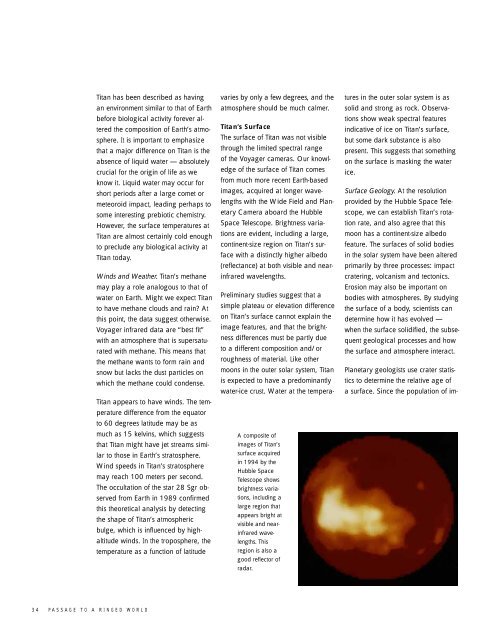Passage to a Ringed World - NASA's History Office
Passage to a Ringed World - NASA's History Office
Passage to a Ringed World - NASA's History Office
You also want an ePaper? Increase the reach of your titles
YUMPU automatically turns print PDFs into web optimized ePapers that Google loves.
34 PASSAGE TO A RINGED WORLD<br />
Titan has been described as having<br />
an environment similar <strong>to</strong> that of Earth<br />
before biological activity forever altered<br />
the composition of Earth’s atmosphere.<br />
It is important <strong>to</strong> emphasize<br />
that a major difference on Titan is the<br />
absence of liquid water — absolutely<br />
crucial for the origin of life as we<br />
know it. Liquid water may occur for<br />
short periods after a large comet or<br />
meteoroid impact, leading perhaps <strong>to</strong><br />
some interesting prebiotic chemistry.<br />
However, the surface temperatures at<br />
Titan are almost certainly cold enough<br />
<strong>to</strong> preclude any biological activity at<br />
Titan <strong>to</strong>day.<br />
Winds and Weather. Titan’s methane<br />
may play a role analogous <strong>to</strong> that of<br />
water on Earth. Might we expect Titan<br />
<strong>to</strong> have methane clouds and rain? At<br />
this point, the data suggest otherwise.<br />
Voyager infrared data are “best fit”<br />
with an atmosphere that is supersaturated<br />
with methane. This means that<br />
the methane wants <strong>to</strong> form rain and<br />
snow but lacks the dust particles on<br />
which the methane could condense.<br />
Titan appears <strong>to</strong> have winds. The temperature<br />
difference from the equa<strong>to</strong>r<br />
<strong>to</strong> 60 degrees latitude may be as<br />
much as 15 kelvins, which suggests<br />
that Titan might have jet streams similar<br />
<strong>to</strong> those in Earth’s stra<strong>to</strong>sphere.<br />
Wind speeds in Titan’s stra<strong>to</strong>sphere<br />
may reach 100 meters per second.<br />
The occultation of the star 28 Sgr observed<br />
from Earth in 1989 confirmed<br />
this theoretical analysis by detecting<br />
the shape of Titan’s atmospheric<br />
bulge, which is influenced by highaltitude<br />
winds. In the troposphere, the<br />
temperature as a function of latitude<br />
varies by only a few degrees, and the<br />
atmosphere should be much calmer.<br />
Titan’s Surface<br />
The surface of Titan was not visible<br />
through the limited spectral range<br />
of the Voyager cameras. Our knowledge<br />
of the surface of Titan comes<br />
from much more recent Earth-based<br />
images, acquired at longer wavelengths<br />
with the Wide Field and Planetary<br />
Camera aboard the Hubble<br />
Space Telescope. Brightness variations<br />
are evident, including a large,<br />
continent-size region on Titan’s surface<br />
with a distinctly higher albedo<br />
(reflectance) at both visible and nearinfrared<br />
wavelengths.<br />
Preliminary studies suggest that a<br />
simple plateau or elevation difference<br />
on Titan’s surface cannot explain the<br />
image features, and that the brightness<br />
differences must be partly due<br />
<strong>to</strong> a different composition and/or<br />
roughness of material. Like other<br />
moons in the outer solar system, Titan<br />
is expected <strong>to</strong> have a predominantly<br />
water-ice crust. Water at the tempera-<br />
A composite of<br />
images of Titan’s<br />
surface acquired<br />
in 1994 by the<br />
Hubble Space<br />
Telescope shows<br />
brightness variations,<br />
including a<br />
large region that<br />
appears bright at<br />
visible and nearinfraredwavelengths.<br />
This<br />
region is also a<br />
good reflec<strong>to</strong>r of<br />
radar.<br />
tures in the outer solar system is as<br />
solid and strong as rock. Observations<br />
show weak spectral features<br />
indicative of ice on Titan’s surface,<br />
but some dark substance is also<br />
present. This suggests that something<br />
on the surface is masking the water<br />
ice.<br />
Surface Geology. At the resolution<br />
provided by the Hubble Space Telescope,<br />
we can establish Titan’s rotation<br />
rate, and also agree that this<br />
moon has a continent-size albedo<br />
feature. The surfaces of solid bodies<br />
in the solar system have been altered<br />
primarily by three processes: impact<br />
cratering, volcanism and tec<strong>to</strong>nics.<br />
Erosion may also be important on<br />
bodies with atmospheres. By studying<br />
the surface of a body, scientists can<br />
determine how it has evolved —<br />
when the surface solidified, the subsequent<br />
geological processes and how<br />
the surface and atmosphere interact.<br />
Planetary geologists use crater statistics<br />
<strong>to</strong> determine the relative age of<br />
a surface. Since the population of im-
















